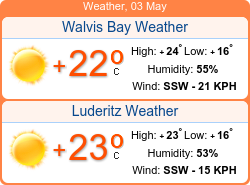Mega Projects
North Port of Walvis Bay, SADC Gateway Development
Overview
The new proposed port, to be built just north of the current built-up area in Walvis Bay, still forms an integral part of what is known as the Port of Walvis Bay. This is because the port limits of the entire Port of Walvis Bay as defined in the Namibian Ports Authority Act (Act 2 of 1994) stretches from the current port in the south northwards up to the area known as Patrysberg close to Swakopmund.
Project description
The project, valued at approximately N$60 billion in today’s terms, consists of developing a 1,330-hectare plot of currently undeveloped land in the town of Walvis Bay, known as Farm 39.
The water area in front of this land will be developed to accommodate port operations, whereas the land will be developed to house various cargo handling terminals.
The development of a dig-out basin, which will reclaim water area from within the land, is also envisaged. The primary reason for this is to allow direct access to the available land via the port.
The reasons for the construction of this new port area are as follows:
The current port is entirely boxed in by the lagoon, the town and the fishing industry.
The current port cannot physically expand its footprint without conducting major land reclamation.
Bulk cargo handling terminals require large spaces of land, which the current port does not have available.
Namibia needs a deep-water seaport at Walvis Bay with sufficient bulk handling capacity to cater for the demand of import and export of mining related cargo.
The current Port of Walvis Bay cannot accommodate large-scale bulk and break-bulk cargo volumes.
Converting the existing container terminal back to a multi-purpose terminal by 2018 will provide some increase in bulk handling capacity to cater for demand until 2022, after which time this too will become insufficient for meeting demand.
Should commercially extractable oil be discovered off the shore of Namibia, the current port will not be able to accommodate the requirements of the oil exploration and drilling industry.
The current port’s liquid bulk handling facilities are simply too small to cater for the huge demand from SADC countries to import fuel and bulk cargo.
The current port’s capacity to accommodate large-scale ship and rig repair operations is limited due to space constraints.
Several mega projects that have surfaced in the SADC region in the last few years will simply not get off the ground without the development of this terminal. These projects include the Trans Kalahari Railway Line, Botswana’s coal exports, mega logistics parks envisaged to be developed in Namibia, Namibia’s crude oil industry, large-scale export of Namibian mining product, and iron ore exports from Namibia, among others.
General features
- A total of 1,330 hectares of new port land, compared with only 105 hectares of land at the current port;
- 10,000 metres of quay walls and jetties to yield approximately 30 large berths (compared with the current port’s 1,900 metres of quay walls);
- World-class ship and rig repair yard, plus an oil and gas supply base;
- Huge dry bulk terminal (>100 million tonnes per annum);
- Car import terminal / ro-ro terminal;
- Passenger terminals;
- Container terminal (if required in future);
- Liquid bulk terminal with VLCC (Very Large Crude Carrier) berths;
- Multi-purpose and break-bulk terminals;
- Backup storage areas and/or dry ports;
- Small craft harbour with port control tower;
- Small boat marinas; and
- New high capacity rail, road, pipeline and conveyor link to the municipal heavy industrial area behind Dune 7 (located 7 miles from Walvis Bay).


